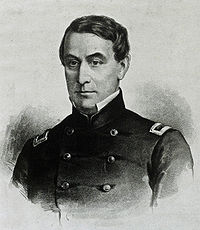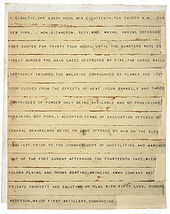- Robert Anderson (Civil War)
-
This article is about the Union officer in the American Civil War. For the Confederate officer in the same war, see Robert Houston Anderson. For other uses, see Robert Anderson (disambiguation).
Robert Anderson 
Lithograph of Major Robert AndersonBorn June 14, 1805
Louisville, KentuckyDied October 26, 1871 (aged 66)
Nice, FrancePlace of burial West Point Cemetery Allegiance United States of America
UnionService/branch United States Army
Union ArmyYears of service 1825–63 Rank Brevet Major General Commands held Fort Sumter Battles/wars Black Hawk War
Second Seminole War
Mexican-American War
American Civil War
(Battle of Fort Sumter)Robert Anderson (June 14, 1805 – October 26, 1871) was an American military leader. He served as a Union Army officer in the American Civil War, known for his command of Fort Sumter at the start of the war. He is often referred to as Major Robert Anderson, referring to his rank at Fort Sumter. In 1871 he died in France at age 66.
Contents
Early life
Anderson was born in "Soldier's Retreat," near Louisville, Kentucky. He graduated from the United States Military Academy (West Point) in 1825 and received a commission as a brevet second lieutenant in the 2nd Regiment of Artillery. He served in the Black Hawk War of 1832 as a colonel of Illinois volunteers, where he had the distinction of twice mustering Captain Abraham Lincoln in and out of army service. Returning to the Army as a first lieutenant in 1833, he served in the Second Seminole War as an assistant adjutant general on the staff of Winfield Scott, and in the Mexican-American War, where he was severely wounded at Molino del Rey, and for which he received a brevet promotion to major. He eventually received a permanent promotion to major of the 1st Regiment of Artillery in the Regular Army on October 5, 1857. He is the author of Instruction for Field Artillery, Horse and Foot in 1839.[1]
Civil War
Fort Sumter
When South Carolina seceded In December 1860, Major Anderson, a pro-slavery, former slave-owner from Kentucky, remained loyal to the Union. He was the commanding officer of United States Army forces in Charleston, South Carolina—the last remaining important Union post in the Deep South. Acting without orders, he moved his small garrison from Fort Moultrie, which was indefensible, to the more modern, more defensible, Fort Sumter in the middle of Charleston Harbor. South Carolina leaders cried betrayal, while the North celebrated with enormous excitement at this show of defiance against secessionism. In February 1861 the Confederate States of America was formed and took charge. Jefferson Davis, the Confederate President, ordered the fort be captured. The artillery attack was commanded by Brig. Gen. P. G. T. Beauregard, who had been Anderson's student at West Point. The attack began April 12, 1861, and continued until Anderson, badly outnumbered and outgunned, surrendered the fort on April 14. The battle began the American Civil War. No one was killed in the battle on either side, but one Union soldier was killed during a 100-gun salute.
The modern meaning of the American flag, according to Adam Goodheart (2011), was forged in December 1860, when Anderson, acting without orders, moved the American garrison from Fort Moultrie to Fort Sumter, in Charleston Harbor, in defiance of the overwhelming power of the new Confederate States of America. Goodheart argues this was the opening move of the Civil War, and the flag was used throughout the North to symbolize American nationalism and rejection of secessionism.
- Before that day, the flag had served mostly as a military ensign or a convenient marking of American territory, flown from forts, embassies, and ships, and displayed on special occasions like the Fourth of July. But in the weeks after Major Anderson's surprising stand, it became something different. Suddenly the Stars and Stripes flew -- as it does today, and especially as it did after September 11 -- from houses, from storefronts, from churches; above the village greens and college quads. For the first time American flags were mass-produced rather than individually stitched and even so, manufacturers could not keep up with demand. As the long winter of 1861 turned into spring, that old flag meant something new. The abstraction of the Union clause was transfigured into a physical thing: strips of cloth that millions of people would fight for, and many thousands die for.[2]
Anderson's actions in defense of American nationalism made him an immediate national hero. He was promoted to brigadier general, effective May 15. Anderson took the fort's 33-star flag with him to New York City, where he participated in a Union Square patriotic rally that was the largest public gathering in North America up to that time.
Civil War roles
Anderson then went on a highly-successful recruiting tour of the North. His next assignment placed him in another sensitive political position, commander of the Department of Kentucky (subsequently renamed the Department of the Cumberland), in a border state that had officially declared neutrality between the warring parties. He served in that position from May 28, 1861, until failing health required his replacement, by Brig. Gen. William T. Sherman, on October 6, 1861.
General Anderson's last assignment of his military career was as commanding officer of Fort Adams in Newport, Rhode Island, in August 1863. By coincidence, Fort Adams had been General Beauregard's first assignment after his graduation from West Point. Anderson officially retired from the Army on October 27, 1863, and saw no further active service.
Later life
Days after Robert E. Lee's surrender at Appomattox and the effective conclusion of the war, Anderson returned to Charleston in the uniform of a brevet major general (ranking as of February 3, 1865) and, four years after lowering the 33-star flag in surrender, raised it in triumph over the recaptured but badly battered Fort Sumter during ceremonies there. (The same evening, April 14, 1865, President Abraham Lincoln was assassinated). A notable post-war achievement of Anderson took place in Braintree, Massachusetts, in 1869, when he visited Braintree to discuss the future of the U.S. Army with the "father of the United States Military Academy," Major General Sylvanus Thayer. An outcome of that visit was establishment of the Military Academy's Association of Graduates (AoG).[3]
Anderson died in Nice, France, and is buried at West Point Cemetery.
Family
Anderson's mother Sarah Marshall was first cousin to Chief Justice John Marshall.[4] Anderson's brother, Charles Anderson, served as Governor of Ohio from 1865 to 1866. Another brother, William Marshall Anderson, was a Western explorer and Ohio attorney. A zealous Catholic and Confederate sympathizer, he briefly moved to Mexico during the reign of Emperor Maximilian in hopes of establishing a Confederate colony there.[5][6] W. Marshall Anderson's son, Thomas M. Anderson, was a brigadier general who fought in the Spanish-American War and Philippine-American War.
Anderson was the great-uncle of Ambassador Larz Anderson, a Washington, D.C. socialite, who donated his house to serve as the headquarters of the Society of the Cincinnati.[7] He was also the great-grandfather of actor Montgomery Clift[8] (only if Clift's mother's story about her adoption and family line is correct - see Montgomery Clift) and the first cousin twice removed of William Clark and George Rogers Clark.
See also
Notes
- ^ Eicher, p. 105.
- ^ Adam Goodheart, "Prologue," in 1861: The Civil War Awakening (2011)
- ^ Kershner, James William, Sylvanus Thayer – A Biography, Arno Press, New York, 1982, p. 329.
- ^ ANDERSON FAMILY PAPERS 1810-1848
- ^ Anderson, William Marshall (edited by Ramon Eduardo Ruiz), An American in Maximilian's Mexico, 1865-1866; the diaries of William Marshall Anderson, Huntington Library, San Marino, 1959, 132p.
- ^ This and other Anderson family papers are kept at the Huntington Library in California:Anderson Family Papers 1810-1848.
- ^ Anderson, William Pope. Anderson Family Records. Cincinnati: Press of W.F. Schaefer, 1936.
- ^ Bosworth, Patricia, Montgomery Clift: A Biography (1978).
References
- Eicher, John H., and Eicher, David J., Civil War High Commands, Stanford University Press, 2001, ISBN 0-8047-3641-3.
- Lawton, Eba Anderson, Major Robert Anderson and Fort Sumter, 1861 (New York, 1911).
- Warner, Ezra J., Generals in Blue: Lives of the Union Commanders, Louisiana State University Press, 1964, ISBN 0-8071-0822-7.
- "Robert Anderson Biography". http://www.civilwarhome.com/Andersonbio.htm. Retrieved 2006-10-01.
External links
Categories:- 1805 births
- 1871 deaths
- Union Army generals
- People from Louisville, Kentucky
- People of Kentucky in the American Civil War
- American military personnel of the Mexican–American War
- United States Army generals
- United States Military Academy alumni
- People of the Black Hawk War
- Burials at West Point Cemetery
Wikimedia Foundation. 2010.




